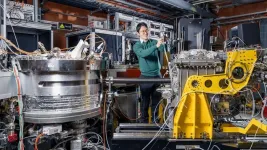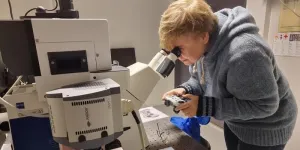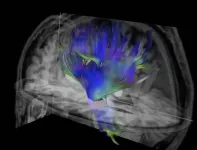(Press-News.org)
Scientists have revealed how lattice vibrations and spins talk to each other in a hybrid excitation known as an electromagnon. To achieve this, they used a unique combination of experiments at the X-ray free electron laser SwissFEL. Understanding this fundamental process at the atomic level opens the door to ultrafast control of magnetism with light.
Within the atomic lattice of a solid, particles and their various properties cooperate in wave like motions known as collective excitations. When atoms in a lattice jiggle together, the collective excitation is known as a phonon. Similarly, when the atomic spins - the magnetisation of the atoms -move together, it’s known as a magnon.
The situation gets more complex. Some of these collective excitations talk to each other in so-called hybrid excitations. One such hybrid excitation is an electromagnon. Electromagnons get their name because of the ability to excite the atomic spins using the electric field of light, in contrast to conventional magnons: an exciting prospect for numerous technical applications. Yet their secret life at an atomic level is not well understood.
It’s been suspected that during an electromagnon the atoms in the lattice wiggle and the spins wobble in an excitation that is essentially a combination of a phonon and a magnon. Yet since they were first proposed in 2006, only the spin motion has ever been measured. How the atoms within the lattice move – if they move at all - has remained a mystery. So too has an understanding of how the two components talk to each other.
Now, in a sophisticated series of experiments at the Swiss X-ray free-electron laser SwissFEL, researchers at PSI have added these missing pieces to the jigsaw. “With a better understanding of how these hybrid excitations work, we can now start to look into opportunities to manipulate magnetism on an ultrafast timescale,” explains Urs Staub, head of the Microscopy and Magnetism Group at PSI, who led the study.
First the atoms, then the spins
In their experiments at SwissFEL, the researchers used a terahertz laser pulse to induce an electromagnon in a crystal of multiferroic hexaferrite. Using time-resolved X-ray diffraction experiments they then took ultrafast snapshots of how the atoms and spins moved in response to the excitation. With this, they proved both that the atoms within the lattice really do move in an electromagnon and also revealed how energy is transferred between lattice and spin.
A striking outcome of their study was that the atoms move first, with the spins moving fractionally later. When the terahertz pulse strikes the crystal, the electric field pushes the atoms into motion, initiating the phononic part of the electromagnon. This motion creates an effective magnetic field that subsequently moves the spins.
“Our experiments revealed that the excitation does not move the spins directly. It was previously unclear whether this would be the case,” explains Hiroki Ueda, beamline scientist at SwissFEL and the first author of the publication.
Going further, the team could also quantify how much energy the phononic component acquires from the terahertz pulse and how much energy the magnonic component acquires through the lattice. “This is an important piece of information for future applications in which one seeks to drive the magnetic system,” adds Ueda.
One free electron laser, two beamline, two crystal modes
Key to their discovery was the ability to measure both the atomic motions and the spins in complementary time-resolved X-ray diffraction experiments at the hard and soft X-ray beamlines of SwissFEL.
Using hard X-rays at the Bernina experimental station, the team studied the motion of atoms within the lattice. The recently developed set-up of the experimental station including specially designed sample chambers allows unique ultrafast measurements using terahertz fields in solids at very low temperatures.
To study the motion of the spins, the team used soft X-rays, which are more sensitive to changes in magnetic systems. These experiments were performed at the Furka experimental station, which recently entered user operation. By tuning the X-ray energy to a resonance in the material, they could focus specifically on the signal from the spins – information that is usually masked.
“The measurement of the phononic part alone at Bernina was a major step forward. To also be able to access the magnetic motion with Furka is an experimental possibility that exists almost nowhere else in the world,” comments Staub.
Fundamental principle is important for our understanding of other physical processes
Ueda, Staub and colleagues have provided an understanding of the microscopic origin of an electromagnon. This understanding is important not only to this physical process, but in a more general sense.
The fundamental interactions between lattice and spins underpin many physical effects that give rise to unusual - and potentially very useful - material properties: for example, high temperature superconductivity. Only with a better understanding of such effects comes control.
Text: Paul Scherrer Institute / Miriam Arrell
END
Far too many antibiotics are used around the world. As a result, bacteria are becoming resistant.
Curing bacterial diseases is becoming more difficult than before, because antibiotics are perhaps our foremost weapons in the fight against them.
An important step towards using fewer antibiotics is to find better methods for identifying pathogens, and here is the good news.
“We have developed a simple tool that can identify all of the genetic material in bacteria. This allows us to find out more quickly what kind of bacteria a sick person or animal is affected ...
As Americans gear up for winter, many will face one of their toughest foes: ice. From delaying flights to making roads slippery, ice accumulation on surfaces wreaks havoc in many ways.
But not all ice is created equal. In new research from the University of Illinois Chicago, scientists studied the stickiness of ice containing everyday contaminants such as salt, soap and alcohol. Most laboratory studies typically test ice made from pure water, but in nature, ice is seldom pure.
“Be it dirty sidewalks or the hull of ...
Philadelphia, November 28, 2023 – Researchers from Children’s Hospital of Philadelphia (CHOP) found that seizure patterns and response to treatment strategies were able to help clinical teams determine epilepsy and developmental trajectories for patients with STXBP1-related disorders, one of the most common genetic epilepsy disorders. The findings were published online by the journal Brain.
Disease-causing variants in the gene STXBP1 are implicated in one of the most common genetic epilepsies and neurodevelopmental disorders, which are sometimes accompanied by autism spectrum disorder, increased or decreased muscle tone, or movement disorders. ...
An international study group led by researchers of Children’s Hospital of Philadelphia (CHOP) have identified how three novel genes cause neurodevelopmental disorders. Researchers now have a better sense of the genes’ roles in human brain development and function and their ability to serve as potential therapeutic targets in the future. The findings were recently published online by the Journal of Clinical Investigation.
Over the last couple of decades, researchers have identified more than 1500 genes in different signaling pathways associated ...
DALLAS, November 28, 2023 — Cardiovascular disease (CVD) claims more lives than all forms of cancer, yet many women, particularly younger women, remain unaware.[1] Through its Go Red for Women® movement, the American Heart Association, which is devoted to a world of healthier lives for all, is being supported by Miss America’s Scholarship Foundation to empower the next generation of women to take charge of their health and make a lasting impact on the health and well-being of communities nationwide.
The ...
Nanodiamonds are 2-8 nm carbon nanoparticles, which can be easily functionalized with various chemical groups like carboxylic groups or drugs. Previous research has shown that actively dividing cells are more likely to absorb nanodiamonds and that epithelial cells treated with carboxylic nanodiamonds lose the ability to migrate across cell permeable cellulose membranes. Rajiv K. Saxena and colleagues explored whether nanodiamonds might block tumor metastasis, a process that requires cell migration to new areas. The authors treated B16F10 melanoma cells with carboxylic nanodiamonds in culture and tested their ability to migrate and ...
Decarbonization of the global economy will require the production of a large number of batteries for electric vehicles (EVs). However, these batteries require energy and an array of minerals to produce and are not without their own environmental impacts. Fanran Meng and colleagues trace the energy consumption and greenhouse gas emissions in the global productions and supply chains of two common battery technologies as well as their future variants: nickel-manganese-cobalt (NMC) and lithium-iron-phosphate (LFP). Today, two-thirds of battery-related emissions occur in China (45%), Indonesia (13%), and Australia (9%), in part due to emissions-intensive electricity for ...
The Icahn School of Medicine at Mount Sinai announced today the launch of a new center for “Research on Emerging Substances, Poisoning, and Overdose, for New Discoveries,” to be known as the RESPOND Center. Its research findings could lead to major advances in this area of medicine, including better treatments for patients with drug overdoses in emergency departments across the United States.
“Each day, clinicians on the front lines bear witness to devastating impacts from the current epidemic ...
CHICAGO – New research being presented this week at the annual meeting of the Radiological Society of North America (RSNA) links soccer heading – where players hit the ball with their head – to a measurable decline in the microstructure and function of the brain over a two-year period.
“There is enormous worldwide concern for brain injury in general and in the potential for soccer heading to cause long-term adverse brain effects in particular,” said senior author Michael L. Lipton, M.D., Ph.D., professor of radiology at Columbia University’s Vagelos College of Physicians and Surgeons and affiliate professor of ...
CHICAGO – Smoking marijuana in combination with cigarettes may lead to increased damage of the lung’s air sacs, according to research being presented today at the annual meeting of the Radiological Society of North America (RSNA).
It is commonly believed that smoking marijuana is not harmful to the lungs. There is an abundance of established research that identifies the harms of cigarette smoking. In contrast, very little is known about the effects of marijuana smoking, and even less research has been done on the combined effects of smoking marijuana and cigarettes.
“Marijuana is the most widely used illicit psychoactive ...







